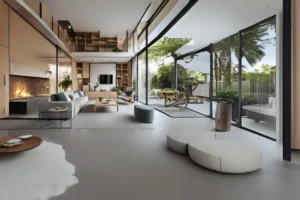Choosing the right colors for your child’s room can feel like a daunting task. It’s more than just aesthetics; color plays a crucial role in shaping their mood, fostering creativity, and even influencing their sleep patterns. This blog is your comprehensive guide to navigating the world of kids’ room color palettes, offering expert advice, inspiring ideas, and practical tips to help you create a space your child will love. From understanding the psychology of color to choosing age-appropriate hues and incorporating your child’s personality, we’ll cover everything you need to know. And if you’re looking to bring these colorful visions to life with a professional touch, Renovationday specializes in creating beautiful and functional spaces for families. We’re here to help you transform your child’s room into a vibrant and inspiring haven. Let’s dive in!
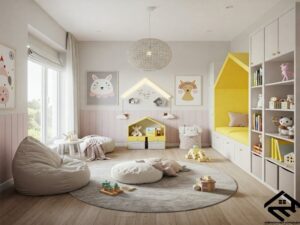
Creating a Haven: The Role of Color in Child Development
Choosing the right paint color for your child’s room involves more than just picking a pretty shade! In other words:
- Age Matters: Think about your child’s age and developmental stage. Soft pastels and calming, gender-neutral colors work beautifully for babies and toddlers, creating a soothing and nurturing environment.
- Let Them Be Involved (When They’re Old Enough): As your child grows, their personality and preferences will start to shine. Letting them have a say in the color selection process is a fantastic way to build their sense of ownership and ensure they adore their new room.
- Room Size is Key: The size of the room plays a big role. Lighter, brighter colors are your best friend in smaller rooms, creating an illusion of more space. Larger rooms can handle bolder, more saturated colors without feeling overwhelming.
- Consider the Light: Pay close attention to the natural light in the room. Rooms with lots of sunlight can handle a wider range of colors, while rooms with limited natural light need brighter shades to prevent a dark and closed-in feeling.
- Don’t Forget the Details: Think about how the paint color will work with existing furniture, bedding, and décor. Creating a cohesive look will make the room feel more put-together and inviting.
- Test It Out: Before committing to a color, test it on a small section of the wall. Observe how it looks at different times of day and under different lighting conditions. This will help you avoid any surprises later on.
Have Fun! Choosing paint colors should be an enjoyable experience. Don’t be afraid to experiment and get creative. Ultimately, the goal is to create a space that your child loves and feels comfortable in.
Here are some videos that might be helpful:
Kids room color paint||paints for kids room tips||interior home room
Best Color choices for Kid’s bedroom
Design kids room (tricks & trips)
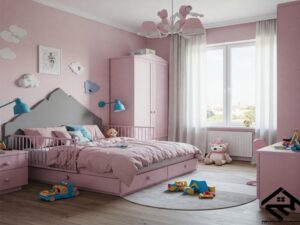
Ready to transform your child’s room into a magical retreat?
Top Blue Paint Picks for Kids’ Rooms
Now that we’ve discussed the power of color, let’s explore some top paint picks. Blue hues are a classic choice, known for their ability to transport kids to a world of peaceful dreams. Imagine a room painted in the softest shade of sky blue, creating a sense of airy spaciousness, or a richer indigo, adding a touch of sophisticated charm. From gentle whispers of color to bold, vibrant statements, the versatility of blue makes it a perfect canvas for your child’s imagination.
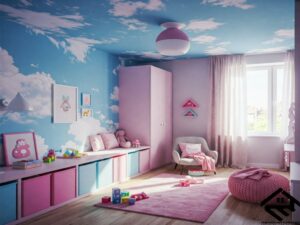
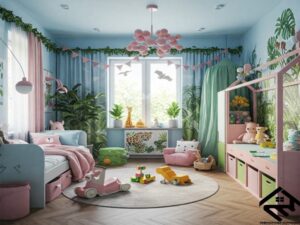
Tickled Pink & Purple: Designing a Delightful Child’s Room
Soft pinks create a soothing and nurturing ambiance, perfect for a child’s room designed for relaxation and peaceful sleep. Think delicate blush tones, gentle rose hues, and pastel tints that evoke a sense of calm and tranquility. These shades can be used as a primary color for the walls, or incorporated through bedding, curtains, and other decorative elements. Paired with complementary colors like soft whites, creams, or light grays, soft pinks create a dreamy and comforting space where children can feel safe and secure. This palette fosters a sense of warmth and tenderness, making it ideal for nurseries or young children’s bedrooms.

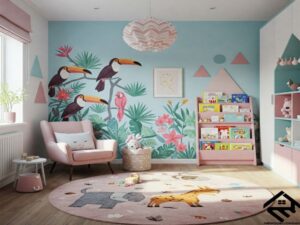
Creating a Cozy Retreat: The Power of Warm Grays in Kids’ Rooms
Warm grays offer a sophisticated and versatile foundation for a child’s room, providing a calming and neutral backdrop that can be easily personalized. Unlike stark, cold grays, these warmer tones possess subtle hints of beige or brown, creating a cozy and inviting atmosphere. They work beautifully as a primary wall color, allowing colorful accents to truly pop. Think of pairing warm grays with natural wood furniture, soft textures like wool or linen, and pops of color in artwork, bedding, or rugs. This palette fosters a sense of tranquility and adaptability, making it suitable for children of all ages and allowing for easy transitions as their tastes and interests evolve. Warm grays also lend themselves well to a variety of design styles, from modern minimalist to cozy farmhouse.
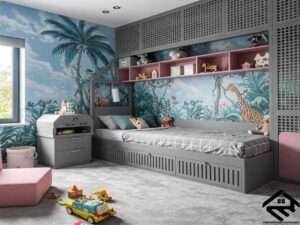
Hello, Sunshine!: Designing a Delightful Yellow Room
Energetic yellows are fantastic for creating a lively and stimulating space in a child’s room. Think of sunny, cheerful shades that evoke feelings of happiness, optimism, and creativity. Yellow can be used as a primary wall color in lighter tints, or as a vibrant accent color through bedding, artwork, and decorative accessories. It pairs beautifully with crisp whites, playful blues, or even touches of green for a nature-inspired feel. This color palette is particularly well-suited for playrooms or creative spaces where you want to encourage energy and imagination. However, it’s important to use yellow thoughtfully, as overly bright or intense shades can sometimes be overstimulating. Balancing yellow with calming neutrals or softer pastels is key to creating a space that is both fun and functional.
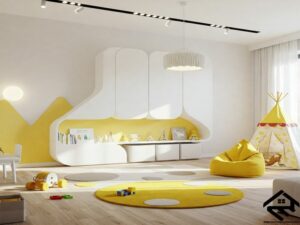
Color combinations : magic beauty for a kid’s room
good color combinations for a child’s room, categorized by the mood or feeling they evoke:
Calm & Soothing:
- Light Blue & White: Classic, airy, and peaceful. Great for promoting sleep and relaxation. Add touches of warm wood tones for coziness.
- Lavender & Soft Gray: Gentle and dreamy. Creates a serene and tranquil atmosphere. Works well for nurseries or younger children.
- Sage Green & Cream: Natural and calming. Evokes a sense of nature and tranquility. Good for a gender-neutral space.
- Pale Pink & Warm Gray: Soft and comforting. A more sophisticated take on traditional pink. Pair with white or cream for a light and airy feel.
Energetic & Playful:
- Yellow & Blue: Bright and cheerful. Promotes creativity and optimism. Use a softer yellow to avoid overstimulation.
- Orange & Teal: Vibrant and fun. Creates a playful and energetic atmosphere. Balance with white or gray to avoid being overwhelming.
- Green & White: Fresh and lively. Evokes a sense of nature and growth. Add pops of other bright colors for extra energy.
- Red, White, & Blue (with a twist): A classic combination, but try a softer red (like coral) or a deeper blue (like navy) for a more modern feel.
Creative & Inspiring:
- Teal & Coral: Bold and artistic. Creates a unique and inspiring space. Balance with neutrals to avoid being too stimulating.
- Mustard Yellow & Gray: Sophisticated and modern. Promotes creativity and focus. Use a lighter gray to keep the room bright.
- Navy Blue & White: Classic and elegant. Creates a sense of calm and focus. Add pops of bright color for personality.
- Emerald Green & Gold: Luxurious and playful. Creates a rich and inspiring atmosphere. Use sparingly to avoid being overwhelming.
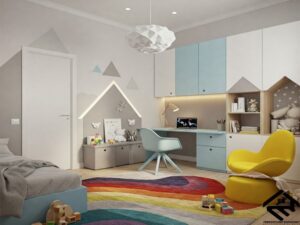
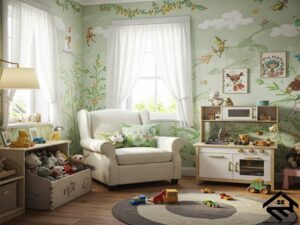
Adding Personality: Designing Unique and Engaging Kids’ Spaces
Accent walls offer a fantastic way to inject personality and visual interest into a child’s room. By painting one wall in a bold, contrasting color or applying a fun wallpaper pattern, you can instantly create a focal point and add depth to the space. This designated area can then become the backdrop for showcasing artwork, displaying themed décor, or even serving as a stage for imaginative play. Consider using a vibrant hue to energize a playroom or a calming shade to create a cozy reading nook. Accent walls are a versatile tool that allows you to experiment with color and pattern without overwhelming the entire room, offering a dynamic and engaging element in your child’s overall design.
- Prepping Your Child’s Room for a Paint Makeover
Before transforming your child’s room with a fresh coat of paint, proper preparation is essential for a smooth and successful project. Start by clearing the space, removing as much furniture, toys, and other items as possible. This not only creates ample room to maneuver while painting but also protects your belongings from potential paint splatters or spills. A clean and clutter-free space will make the painting process significantly easier and more efficient.
- Cleaning and Repairing Walls Before Painting
Once the room is cleared, the next crucial step is preparing the walls themselves. Begin with a thorough cleaning to remove any dust, grime, or cobwebs that may have accumulated. A damp cloth or sponge, along with a mild detergent solution, usually does the trick. Next, carefully inspect the walls for any imperfections. Small cracks, holes from nails, or dents can be easily patched with spackle or putty. Allow the patching compound to dry completely according to the product instructions, and then sand the patched areas smooth until they blend seamlessly with the surrounding wall surface. This creates a clean, even canvas that’s ready to receive the paint and ensures a flawless, professional-looking finish.
- Splatter-Free Painting
Protect floors with drop cloths or plastic sheeting. Use painter’s tape to carefully mask baseboards, trim, windows, and fixtures. This prevents paint drips and splatters, ensuring clean lines and easy cleanup.
- Ventilating While Painting
Proper ventilation is crucial during and after painting. Open windows and use fans to circulate fresh air throughout the room. This not only helps the paint dry more quickly and evenly, minimizing wait time, but also significantly reduces the concentration of paint fumes, creating a healthier environment, especially important in a child’s room. Adequate ventilation minimizes the risk of inhaling potentially harmful volatile organic compounds (VOCs) released by paint, ensuring a safer and more comfortable painting experience.
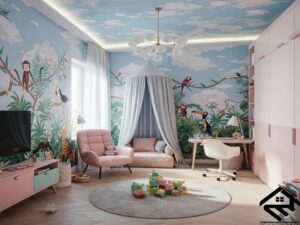
For kids whose tastes change fast:
- Neutral Base: Walls and large furniture in light gray, warm white, or soft beige.
- Changeable Fun: Bedding, curtains, rugs, artwork, and accessories in their current favorite colors/themes. Easy and affordable to swap out.
- Accent Wall (Optional): If you want a bolder color, just paint one wall.
- Undertones Matter: Even neutrals have undertones (warm/cool), so choose wisely.
- Involve Them (A Little): Let them pick changeable items within your chosen palette.
This way, their room can evolve with them without constant repainting!
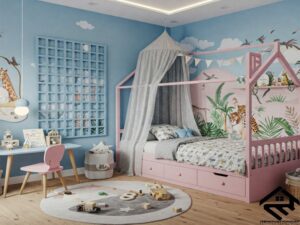
A Rainbow of Dreams
From soothing pastels to vibrant hues, the possibilities for your child’s room are endless. Remember the key takeaways: consider your child’s personality and interests, experiment with different palettes, and don’t forget the essential prep work. Now, armed with this knowledge, go forth and create a space that your child will adore for years to come. Need help bringing your vision to life? Contact Renovationday for a free consultation and let our team of experts guide you through the process. We’d also love to see your creations! Share your before-and-after photos on social media using



